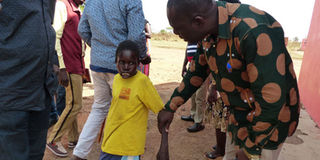Nodding syndrome breakthrough research excites Acholi leaders

Affected. Kilak South MP Gilbert Olanya interacts with Balam Opiyo 23, one of the victims of nodding syndrome in Omoro District in February last year. FILE PHOTO
What you need to know:
- About the disease. Nodding syndrome is a mentally and physically disabling disease that only affects children, typically between the ages of 5 and 15. An estimated 3,000 children mainly in Kitgum, Pader and Omoro districts were affected by Nodding Syndrome and some 130 have died since 2009 when it was first detected.
KITGUM/OMORO. Leaders in Acholi Sub-region have commended the findings recently published by a group of six researchers on the causes of Nodding Syndrome.
The findings were first published last week in Acta Neuropathologica-Springer, a peer reviewed monthly journal on neuropathology.
This followed a year-long research and multiple examinations of brain tissues of children who died of Nodding Syndrome in northern Uganda ever since the disease was detected in 2009.
The researchers in their findings concluded that the condition is a result of abnormal deposit of protein in the brains.
The team
The scientific research was led by Prof Michael Pollanen from Forensic Pathology at the University of Ontario, and Uganda’s consultant pathologist, Dr Sylvester Onzivua.
Other researchers included Dr Janice Robertson and Dr Paul M McKeever, both from University of Toronto, and Gulu University’s Prof David Kitara, Dr Francis Olwa and Dr Amanda Fong.
Mr Douglas Peter Okello, the Omoro District chairperson, on Tuesday told Daily Monitor that the research findings come as a relief to the many questions people in the region have been asking.
“I am impressed that the suffering of our people would be medically solved, this means that those affected and recovering from the syndrome will be provided the right medication,” Mr Okello said.
He said in the past, several scientists carried researches but the findings were never released to the district leaders and families of those affected by Nodding Syndrome.
“The Centers for Disease Control and Prevention [CDC] and the Ministry of Health carried out research on the victims of nodding syndrome but to date; we have not been given findings to ascertain what causes this strange ailment. This left many people especially families of those affected by the syndrome raising serious concerns,” Mr Okello said.
In July 2014, Scientists investigating the cause of Nodding Syndrome at the Centers for Disease Control in Atlanta, USA, found crystal-like substances in portions of brains of children affected by the strange illness.
The Kitgum District chairperson, Mr Jackson Omona, said the research findings will help put to rest speculation among the locals and leaders in the area on the causes of Nodding Syndrome.
“We believe through this finding the right treatment could be put in place to help end the plight of the people suffering from Nodding Syndrome,” he said.
According to Mr Omona, the district has a total of 532 children who are still recovering from the disease and that two died in last year.
INTERVENTION
Funding. In March, government earmarked Shs1.4b as emergency funds for boosting the response to Nodding Disease Syndrome in the region.
This came after the closure of the nodding treatment centres in Odek Sub-county, Omoro District in December 2017 when Hope for Humans; a non-governmental organisation, stopped funding the centre citing financial constraints. Early this year, local leaders in Omoro alleged that there were new cases of Nodding Syndrome in the region.
Ministry of Health later intervened and conducted clinical audit and cited the cases were epilepsy.
About the disease. Nodding syndrome is a mentally and physically disabling disease that only affects children, typically between the ages of 5 and 15. An estimated 3,000 children mainly in Kitgum, Pader and Omoro districts were affected by Nodding Syndrome and some 130 have died since 2009 when it was first detected.




